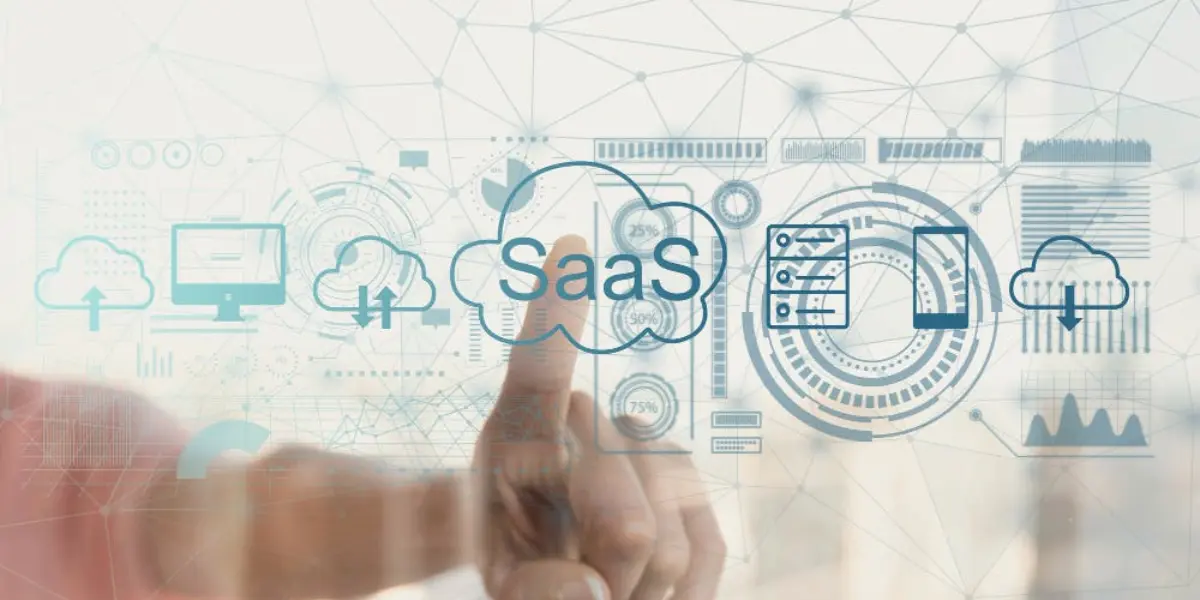The SaaS Phenomenon
Key Drivers of SaaS Popularity
The SaaS model has seen exponential growth due to its numerous advantages over on-premise software deployments. For example, 47% of venture capital funding in 2023 went to companies with a SaaS business model[2]. Further, it’s estimated that by 2025, 85% of business apps will be SaaS-based[3]. This growth is driven by SaaS applications’ ability to provide flexible, scalable, and cost-effective software solutions. Businesses, from startups to large enterprises, are increasingly relying on SaaS for critical applications such as customer relationship management (CRM), human resources management, financial management, and more.
Cost Efficiency
One of the primary drivers behind the adoption of SaaS is its cost efficiency. SaaS eliminates the need for organizations to purchase, install, update, and maintain hardware and software systems. Instead, the SaaS provider manages all potential technical issues, and the customer pays a subscription fee that typically includes support, maintenance, and periodic upgrades. This shift from a capital expenditure (CapEx) model to an operational expenditure (OpEx) model allows businesses to allocate resources more flexibly and predictably.
Scalability and Accessibility
Another advantage of SaaS is its inherent scalability, which allows businesses to easily scale their usage up or down based on their needs without requiring significant changes to their IT infrastructure. Additionally, SaaS applications are accessible from anywhere, which is particularly beneficial in today’s increasingly remote and distributed work environments. This accessibility enhances collaboration among geographically dispersed teams and contributes to higher productivity levels.
Rapid Deployment and Innovation
SaaS applications are typically available for use almost immediately after a subscription is initiated, which drastically reduces the time and effort required for deployment compared to traditional software. Moreover, SaaS providers frequently update their offerings to include new features and improvements, ensuring that all users benefit from the latest functionalities without additional upgrade costs or downtime. This continuous innovation cycle encourages businesses to remain agile and competitive.
Market Impact
The SaaS model not only influences how companies consume technology but also affects how they operate and compete. In sectors like e-commerce, digital media, and professional services, the ability to quickly adapt and scale technology solutions without significant capital investment can be a major determinant of success. Furthermore, as SaaS continues to evolve, it is beginning to incorporate emerging technologies such as artificial intelligence (AI) and machine learning (ML), offering even more advanced capabilities and analytics to businesses.
The SaaS phenomenon has transformed the software industry by democratizing access to advanced technology solutions. Its continued growth signifies a permanent shift in how businesses invest in and utilize software, suggesting that the influence of SaaS will only deepen as more companies worldwide embrace its benefits.
Things to Consider Before Migrating to SaaS
When contemplating the migration to a SaaS model, businesses developing and selling software must carefully evaluate various strategic and operational aspects. This ensures that their shift aligns not only with internal capabilities and goals but also with external market demands and trends. Below, we delve into the essential considerations businesses should address before moving to SaaS.
Understanding Customer Needs
The decision to switch to SaaS should start with a deep dive into market research to understand current trends, competitor strategies, and, most importantly, customer demands. Are customers looking for solutions that offer flexibility, scalability, and cost-effectiveness that SaaS models provide? Conducting surveys, analyzing market reports, and gathering feedback from current users can provide valuable insights that will inform the feasibility and scope of the SaaS offering.
Evaluating Financial Implications
Transitioning to SaaS involves significant changes in how revenue is generated and recognized. Unlike one-time sales, SaaS models are based on recurring revenue streams. Businesses need to develop a robust financial model that considers recurring revenue, churn rates, customer acquisition costs, and long-term customer value. Pricing strategy also plays a crucial role—determining whether a flat-rate, usage-based, or tiered pricing model will be most appealing to the target market while sustaining business operations.
Developing a Suitable Technical Infrastructure
Migrating to SaaS requires a solid technical foundation capable of supporting web-based services that are reliable and scalable. This includes:
- Cloud Infrastructure: Choosing the right cloud service provider or deciding whether to use a public, private, or hybrid cloud can impact performance and scalability.
- Security Measures: Implementing advanced security protocols to protect data and ensure privacy is crucial, especially to comply with regulations like GDPR or HIPAA.
- Software Architecture: Developing a multi-tenant architecture that allows multiple customers to share the same application securely and efficiently, while also offering customization options.
Planning for Integration and Data Migration
For businesses with existing customers, transitioning from an on-premise to a SaaS model involves migrating customer data to the new system. This process needs to be carefully planned in the roadmap to minimize downtime and data loss. Additionally, the SaaS platform should be capable of integrating seamlessly with other tools and systems that customers are already using, which enhances user experience and utility.
Regulatory Compliance and Data Governance
Depending on the industry and the nature of the data handled, software businesses must ensure that their SaaS offering complies with relevant laws and regulations. This can include international data protection regulations, industry-specific standards, and local legal requirements. It’s essential to have a clear understanding of these requirements and to implement policies and technology solutions that enforce compliance.
Change Management and Customer Communication
Migrating to SaaS not only changes the technical dynamics of a product but also affects the company’s internal processes and the customer’s interaction with the product. Effective change management strategies are essential to manage this transition smoothly. This includes training teams, updating internal processes, and maintaining clear and continuous communication with customers to ensure they are aware of how these changes will benefit them.
By carefully considering these factors, businesses can better prepare for a successful transition to a SaaS model, ensuring that the move is strategically aligned with both market needs and long-term business objectives.
Is Migrating to a SaaS Model Always the Right Choice?
While the benefits of SaaS are numerous, there are valid reasons why a software business might choose to delay or avoid migrating from an on-premise model:
High Customization Needs of Current Customers
If the customer base has extensive customization needs that are deeply integrated into their operations, the standardized approach of SaaS may not meet all customer requirements, potentially leading to customer dissatisfaction and churn.
Substantial Investment in Existing Infrastructure
Companies that have recently invested heavily in their own infrastructure may find that moving to a SaaS model is not cost-effective in the short term. The sunk costs in existing hardware and software can delay the return on investment from transitioning to SaaS.
Regulatory and Data Residency Concerns
Certain industries are subject to stringent regulatory requirements that might dictate data residency, making the decentralized nature of SaaS problematic. In such cases, maintaining an on-premise solution might be necessary to comply with legal requirements.
Reliability and Control
Dependence on an external provider for critical business operations can introduce risks related to downtime and loss of control over performance and security standards. Companies might prefer to maintain control over their IT environment to ensure reliability and security according to their standards.
Conclusion
The transition from on-premise to SaaS is a transformative journey that offers software businesses the opportunity to align more closely with modern customer expectations and market trends. While the benefits of SaaS are clear, including recurring revenue, enhanced scalability, and improved customer engagement, the decision to migrate should be strategically planned.
Businesses must carefully evaluate their current infrastructure, customer base, and market dynamics. They must also consider potential challenges such as the need for substantial upfront investment, changes in customer support requirements, and ensuring data security and compliance.
Ultimately, successful migration to SaaS not only depends on technical and strategic execution but also on maintaining a clear line of communication with customers to manage expectations and provide value consistently. With careful planning and execution, the shift to SaaS can open up new avenues for growth and innovation, ensuring long-term success in the competitive software market.
Ready to take the next step? Vaultinum provides expert analysis and assessments to help companies navigate the complexities of SaaS migration. By evaluating technical infrastructure, security measures, compliance readiness, and scalability potential, Vaultinum ensures that organizations make informed decisions aligned with their long-term goals. This comprehensive support helps businesses successfully manage their transition, ensuring that they not only meet market demands but also enhance customer satisfaction and achieve sustainable growth.
[1] https://www.fortunebusinessinsights.com/software-as-a-service-saas-market-102222
[2] https://dealroom.co/guides/global
[3] https://pages.bettercloud.com/rs/719-KZY-706/images/2020_StateofSaaSOpsReport.pdf?mkt_tok=NzE5LUtaWS03MDYAAAF8LQdmoC7u54xbqxNwp0au4Zk7SiYaaqq2vupXFxCvaP5vY8gSQtlGFsUsRI8oj5Fl2m5PwIZUUAlzVZL_-hUEQ2RdNqgEzDAmZA5bZtowS_v-zMs

